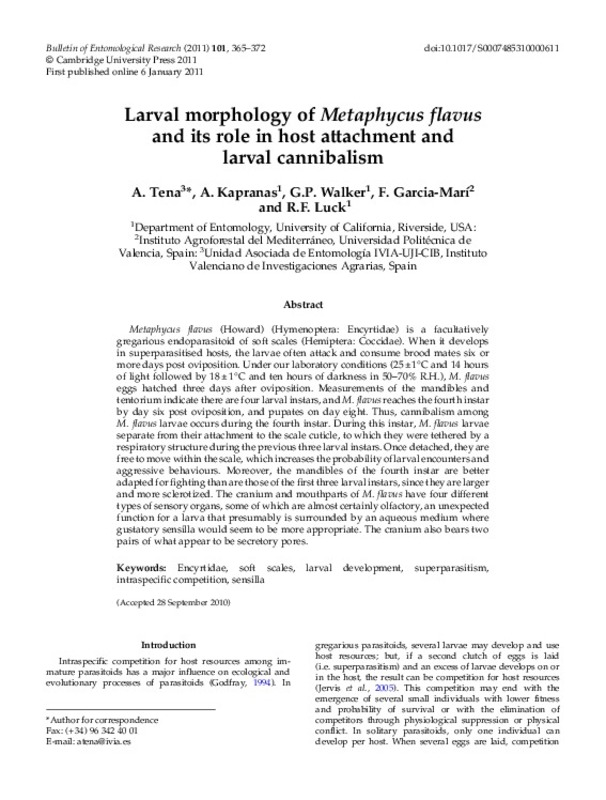Tena Barreda, A.; Kapranas, A.; Walker, G.; García Mari, F.; Luck, R. (2011). Larval morphology of Metaphycus flavus and its role in host attachment and larval cannibalism. Bulletin of Entomological Research. 101(3):365-372. https://doi.org/10.1017/S0007485310000611
Por favor, use este identificador para citar o enlazar este ítem: http://hdl.handle.net/10251/27908
|
Título:
|
Larval morphology of Metaphycus flavus and its role in host attachment and larval cannibalism
|
|
Autor:
|
 Tena Barreda, Alejandro
Kapranas, A
Walker, G.P.
Tena Barreda, Alejandro
Kapranas, A
Walker, G.P.
 García Mari, Ferran
Luck, R.F.
García Mari, Ferran
Luck, R.F.
|
|
Entidad UPV:
|
Universitat Politècnica de València. Departamento de Ecosistemas Agroforestales - Departament d'Ecosistemes Agroforestals
|
|
Fecha difusión:
|
|
|
Resumen:
|
Metaphycus flavus (Howard) (Hymenoptera: Encyrtidae) is a facultatively gregarious endoparasitoid of soft scales (Hemiptera: Coccidae). When it develops in superparasitised hosts, the larvae often attack and consume brood ...[+]
Metaphycus flavus (Howard) (Hymenoptera: Encyrtidae) is a facultatively gregarious endoparasitoid of soft scales (Hemiptera: Coccidae). When it develops in superparasitised hosts, the larvae often attack and consume brood mates six or more days post oviposition. Under our laboratory conditions (25±1°C and 14 hours of light followed by 18±1°C and ten hours of darkness in 50-70% R.H.), M. flavus eggs hatched three days after oviposition. Measurements of the mandibles and tentorium indicate there are four larval instars, and M. flavus reaches the fourth instar by day six post oviposition, and pupates on day eight. Thus, cannibalism among M. flavus larvae occurs during the fourth instar. During this instar, M. flavus larvae separate from their attachment to the scale cuticle, to which they were tethered by a respiratory structure during the previous three larval instars. Once detached, they are free to move within the scale, which increases the probability of larval encounters and aggressive behaviours. Moreover, the mandibles of the fourth instar are better adapted for fighting than are those of the first three larval instars, since they are larger and more sclerotized. The cranium and mouthparts of M. flavus have four different types of sensory organs, some of which are almost certainly olfactory, an unexpected function for a larva that presumably is surrounded by an aqueous medium where gustatory sensilla would seem to be more appropriate. The cranium also bears two pairs of what appear to be secretory pores. Copyright © 2011 Cambridge University Press.
[-]
|
|
Palabras clave:
|
Encyrtidae
,
Intraspecific competition
,
Larval development
,
Sensilla
,
Soft scales
,
Superparasitism
,
Adaptation
,
Aggression
,
Cannibalism
,
Cranium
,
Cuticle
,
Endoparasite
,
Hatching
,
Host-parasitoid interaction
,
Laboratory method
,
Larva
,
Light effect
,
Morphology
,
Oviposition
,
Pupation
,
Secretion
,
Temperature gradient
,
Wasp
,
Animal
,
Article
,
Feeding behavior
,
Head
,
Hemiptera
,
Histology
,
Host parasite interaction
,
Mouth and teeth
,
Parasitology
,
Physiology
,
Species difference
,
Animals
,
Host-Parasite Interactions
,
Species Specificity
,
Stomatognathic System
,
Wasps
,
Coccidae
,
Hymenoptera
,
Metaphycus flavus
|
|
Derechos de uso:
|
Reserva de todos los derechos
|
|
Fuente:
|
Bulletin of Entomological Research. (issn:
0007-4853
)
|
|
DOI:
|
10.1017/S0007485310000611
|
|
Editorial:
|
Cambridge University Press
|
|
Versión del editor:
|
http://www.dx.doi.org/10.1017/S0007485310000611
|
|
Código del Proyecto:
|
info:eu-repo/grantAgreement/USDA//NRI 2005-01006/
info:eu-repo/grantAgreement/CRB//5500-159/
|
|
Agradecimientos:
|
We thank Lisa D. Foster, Porfirio Pacheco and Robert Trautman for providing the scales, host plants and parasitoids to conduct these experiments. This research was supported in part by an USDA National Research Initiative ...[+]
We thank Lisa D. Foster, Porfirio Pacheco and Robert Trautman for providing the scales, host plants and parasitoids to conduct these experiments. This research was supported in part by an USDA National Research Initiative grant (USDA-NRI 2005-01006) awarded to RFL and Jocelyn Millar and by a California Citrus Research Board grant (CRB 5500-159) awarded to Joseph Morse and RFL.
[-]
|
|
Tipo:
|
Artículo
|









